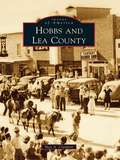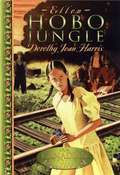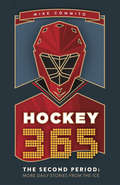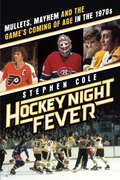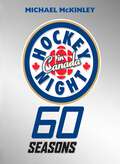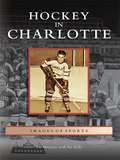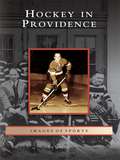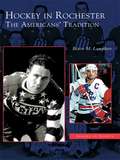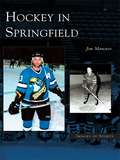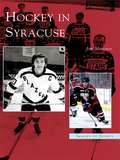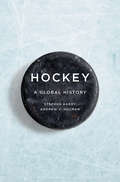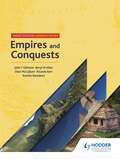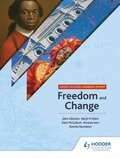- Table View
- List View
Hobbs and Lea County (Images of America)
by Max A. ClampittWhen Lea County was created in 1917 from Eddy and Chaves Counties in the far southeastern corner of New Mexico, it was virtually a blank canvas for new settlers, with few roads, towns, or amenities. At that time, the area was little more than vast pasture lands for cattle, though a handful of hardy folk had already established homesteads in the region. But on June 13, 1928, that all changed when oil was discovered, and almost overnight, an influx of new settlers arrived, and development began in earnest. Oil wells were drilled on ranchers' property, and saloons, stores, and hotels sprang up, especially in the city of Hobbs. The oil boom drove the early economy of Hobbs and Lea County and of southeastern New Mexico, but through boom and bust, the community has endured, and today more than 50,000 residents call it home.
Hobo Jungle: Ellen (Our Candian Girl)
by Dorothy Joan HarrisDuring the Depression in 1939, ten-year-old Ellen misses her life before her father lost his job and her family had to move in with her grandfather in Vancouver.
Hoboes: Bindlestiffs, Fruit Tramps, and the Harvesting of the West
by Mark WymanWhen the railroad stretched its steel rails across the American West in the 1870s, it opened up a vast expanse of territory with very few people but enormous agricultural potential: a second Western frontier, the garden West. Agriculture quickly followed the railroads, making way for Kansas wheat and Colorado sugar beets and Washington apples. With this new agriculture came an unavoidable need for harvest workers—for hands to pick the apples, cotton, oranges, and hops; to pull and top the sugar beets; to fill the trays with raisin grapes and apricots; to stack the wheat bundles in shocks to be pitched into the maw of the threshing machine. These were not the year-round hired hands but transients who would show up to harvest the crop and then leave when the work was finished. Variously called bindlestiffs, fruit tramps, hoboes, and bums, these men—and women and children—were vital to the creation of the West and its economy. Amazingly, it is an aspect of Western history that has never been told. In Hoboes: Bindlestiffs, Fruit Tramps, and the Harvesting of the West, the award-winning historian Mark Wyman beautifully captures the lives of these workers. Exhaustively researched and highly original, this narrative history is a detailed, deeply sympathetic portrait of the lives of these hoboes, as well as a fresh look at the settling and development of the American West.
Hobohemia and the Crucifixion Machine: Rival Images of a New World in 1930s Vancouver
by Todd MccallumIn the early years of the Great Depression, thousands of unemployed homeless transients settled into Vancouver’s “hobo jungle.” The jungle operated as a distinct community, in which goods were exchanged and shared directly, without benefit of currency. The organization of life was immediate and consensual, conducted in the absence of capital accumulation. But as the transients moved from the jungles to the city, they made innumerable demands on Vancouver’s Relief Department, consuming financial resources at a rate that threatened the city with bankruptcy. In response, the municipality instituted a card-control system—no longer offering relief recipients currency to do with as they chose. It also implemented new investigative and assessment procedures, including office spies, to weed out organizational inefficiencies. McCallum argues that, threatened by this “ungovernable society,” Vancouver’s Relief Department employed Fordist management methods that ultimately stripped the transients of their individuality. Vancouver’s municipal government entered into contractual relationships with dozens of private businesses, tendering bids for meals in much the same fashion as for printing jobs and construction projects. As a result, entrepreneurs clamoured to get their share of the state spending. With the emergence of work relief camps, the provincial government harnessed the only currency that homeless men possessed: their muscle. This new form of unfree labour aided the province in developing its tourist driven “image” economy, as well as facilitating the transportation of natural resources and manufactured goods. It also led eventually to the most significant protest movement of 1930s’ Canada, the On-to-Ottawa Trek. Hobohemia and the Crucifixion Machine explores the connections between the history of transiency and that of Fordism, offering a new interpretation of the economic and political crises that wracked Canada in the early years of the Great Depression.
Hockey 365, The Second Period: More Daily Stories from the Ice
by Mike CommitoMore hockey history for every day of the year! Celebrate hockey history with Hockey 365, The Second Period and be reminded of why you love hockey every day of the year. Whether you are a long-suffering Leafs fan or you cheer for a team that has actually won a Stanley Cup in the last half-century, this compendium will give you a hockey-history fix no matter your allegiance. From the National Hockey League’s humble beginnings to the empty seats of the 2020 Stanley Cup Playoffs, Mike Commito has gone back into the vault to bring you even more hockey history. So, get ready, the second period is about to begin.
Hockey 365: Daily Stories from the Ice
by Mike CommitoA hockey history moment for every day of the year! A few seconds can make a game, even a season, and behind each play is a piece of history. Mike Commito marks every day of the year with a great moment in hockey and shows how today's game is part of an ongoing story that dates back to its origins on frozen ponds. From the National hockey League’s first games in 1917 to Auston Matthews's electrifying four-goal debut for the Maple Leafs in 2016, Hockey 365 has something for everyone and is sure to give you a better appreciation for the sport we all love.
Hockey Card Stories: True Tales! From 59 of Your Favourite Players (Hockey Card Stories)
by Ken Reid&“Nobody enjoys the full kaleidoscope of the game quite like Kenny, from banana blades and &’70s staches to air-brushed, mistake-laden hockey cards.&” —Jeff Marek, Sportsnet Hockey host and Marek vs. Wyshynski podcast co-host Hockey Card Stories reveals what was really going on in your favorite old hockey cards through the eyes of the players depicted on them. Some of the cards are definitely worth a few bucks, some a few cents—but every story told here is priceless. Sportsnet&’s Ken Reid presents the cards you loved and the airbrushed monstrosities that made you howl, the cards that have been packed away in boxes forever, and others you can&’t believe ever existed. Whether it&’s a case of mistaken identity or simply a great old photo, a fantastic 1970s haircut and &’stache, a wicked awesome goalie mask or a future Hall of Famer&’s off-season fashion sense, a wide variety of players—from superstars like Bobby Orr, Denis Potvin, and Phil Esposito to the likes of Bill Armstrong who played only one game in the NHL—chime in on one of their most famous cards. &“Hockey Card Stories is a sports fan&’s dream—humorous, detailed and nostalgic. I hope there&’s more where this came from.&” —Terry Ryan, author of Tales of a First-Round Nothing &“Bright, funny and filled with a real love of the sport and a genuine affection for its great characters.&” —Stephen Brunt, author of Searching for Bobby Orr and Prime Time Sports cohost &“When Ken is passionate about a topic, he&’s the most knowledgeable individual in the room . . . in this book, you&’ll quickly appreciate his passion for hockey cards . . . What a nerd.&” —Evanka Osmak, Sportsnet Connected co-anchor
Hockey Night Fever
by Stephen ColeA wildly evocative chronicle of the decade that changed hockey forever. "Lady Byng died in Boston" read a sign in the Garden arena in 1970, a cheery dismissal of the NHL trophy awarded the game's most gentlemanly player. A new age of hockey was dawning. For 30 years, hockey was an orderly and (relatively) well-behaved sport. There was one Commissioner, six teams and five colours--red, white, black, blue and yellow. Oh, and one nationality. Until 1967, every player, coach, referee and GM in the NHL had been a Canadian. And then came NHL expansion, the founding of the WHA, and garish new uniforms. The Seventies had arrived: the era that gave us not only disco, polyester suits, lava lamps and mullets but also the movie Slap Shot and the arrest of ten NHL players for on-ice mayhem. But it also gave us hockey's greatest encounter (the 1972 Canada-Russia Summit), its most splendid team, the 1976-77 Montreal Canadiens, and the most aesthetically satisfying game--the three-all tie on New Year's Eve, 1975, between the Canadiens and the Soviet Red Army. Modern hockey was born in the sport's wild, sensational, sometimes ugly Seventies growth spurt. The forces at play in the decade's battle for hockey supremacy--dazzling speed vs. brute force--are now, for better or worse, part of hockey's DNA. This book is a welcome reappraisal of the ten years that changed how the sport was played and experienced. Informed by first-hand interviews with players and game officials, and sprinkled with sidebars on the art and artifacts that defined Seventies hockey, the book brings dramatically alive hockey's most eventful, exciting decade.
Hockey Night In Canada: 60 Seasons
by Michael MckinleyHockey Night in Canada has reached a great age (and for television, practically an immortal one) because it made itself into something that Canada couldn't live without. It is this surge of emotion that connected us all each week, and which connects us through the years to now. Hockey Night in Canada didn't just aim a camera at a game and observe what happened-it actively gave the country a prism through which it could see itself and its evolving diversity. We look where the eye of Hockey Night in Canada looks, and it looks at us. We remember what it remembers. We feel what it feels. That is the dynamic that has made the show much more than a long-lived TV success; it is a cultural juggernaut. Ask fans where they saw their first hockey game, and chances are it was on Hockey Night in Canada. Ask the players-male or female-what first got them into the rink, and the answer will be the same: they wanted to be like the players on Hockey Night in Canada.
Hockey for Schools (J. T. Hankinson on Sport)
by J. T. HankinsonOriginally published in 1947, this book, the third of the series, deals with hockey coaching and practice in schools. It was produced in a School, and once again the action photographs are of boys who were at that time in the School Team. The author had considerable experience in the coaching of school hockey.The book opens with descriptions of the basic arts: hitting, gathering, dribbling, tackling etc., required of all players, after which the play and tactics of each position on the field are analysed. A specially interesting chapter is that on team tactics and positional play, and this chapter is illustrated by some excellent photographs of a tactical table, in which the dispositions in various situations are diagrammatically set out. Other chapters deal with captaincy, coaching, school organization, how to watch a match, and some explanatory comments on the rules of the game.The book is illustrated by many magnificent action photographs. While this book was primarily for schools, the instructional detail and the attractiveness of the photographs would also have appealed to more mature hockey players. Today it can be enjoyed in its historical context.
Hockey in Broome County (Images of Sports)
by Marvin A. Cohen Michael J. MccannThe Broome Dusters played their first home game at the Broome County Veterans Memorial Arena on October 18, 1973. The game was symbolic of what was to come. Down 6-0, they fought back only to lose 8-7. Their fan support followed a similar pattern, lukewarm at first and then ferociously loyal. Hockey became a passion for local fans and has continued to be so to this day. When the Dusters disbanded, they were followed by the Whalers, Rangers, B.C. Iceman, and the Senators. Hockey in Broome County tells this fascinating story with more than 200 photographs and engaging text. Relive the heroics of the Dusters' Rod Bloomfield, "the little guy that everyone picked on." Then skip ahead to the crowd-pleasing toughness of the Whalers' Randy MacGregor and the more recent brilliance of the Senators' Jason Spezza.
Hockey in Charlotte (Images of Sports)
by Jim Mancuso Pat KellyCharlotte is considered the birthplace of professional hockey in the South. The city of Charlotte, home of the Checkers (originally known as the Clippers), is the greatest Southern town in the history of professional hockey, winning the most play-off championships: three Eastern Hockey League titles, two Southern Hockey League titles, and one East Coast Hockey League title. Several Charlotte players and coaches starred in the National Hockey League--including Walter "Turk" Broda, John Brophy, Fred Creighton, Bill "Cowboy" Flett, Mike Hartman, Pat Kelly, Jackie Leclair, and John Muckler.
Hockey in Dayton (Images of Sports)
by Chuck GabringerIn the 1950s, crowds that equaled half the city of Troy's population filled the newly constructed 3,900-seat Hobart Arena to watch the area's first hockey team, the Troy Bruins, take the ice. In the 1960s and 1970s, fans packed one of hockey's great "barns," Hara Arena, to watch the Dayton Gems become one of the more well-known and successful franchises in all of professional hockey. In the 1990s and 2000s, it was the Dayton Bombers that reignited the area's love for hockey. Hockey in Dayton tells the story of the teams, players, people, and events that have permanently frozen hockey's place in the history of Dayton area sports.
Hockey in Providence (Images of Sports)
by Jim MancusoProvidence has an old and rich hockey tradition. The Providence Reds were one of the first professional hockey teams in the United States. In their 51-year history (1926-1977), the Reds won seven playoff championships, including four Calder Cup titles. The Reds were the first minor-league hockey team to operate for 50 seasons. The Providence Bruins, established in the 1992-1993 season, carry on the city's great hockey legacy and gave Providence its fifth Calder Cup title. Several Hockey Hall of Famers have played for Providence-based teams, including Bobby Bauer, Hector "Toe" Blake, Johnny Bower, Frank Brimsek, Eddie Giacomin, Rod Langway, Milt Schmidt, and Lorne "Gump" Worsley.
Hockey in Rochester: The Americans' Tradition (Images of Sports)
by Blaise M. LamphierRochester, New York, emerged courageously with its first professional hockey team in the fall of 1935: the Rochester Cardinals. However, the venture was short-lived due to the financial strain of the Great Depression. Finally, in 1956, thanks to local visionaries such as Sam Toth and Ed House, Rochester became home to the Americans. The "Amerks" began a legacy of greatness from their inception as a joint affiliate of the legendary Montreal Canadiens and Toronto Maple Leafs. This volume is a salute to those who have shaped Rochester's hockey history for more than thirty-seven hundred games.
Hockey in Springfield (Images of Sports)
by Jim MancusoSpringfield has a dynamic hockey history that dates back 80 years, beginning with the Springfield Indians. One of the first professional hockey teams in the United States, the Indians were an inaugural member of the Canadian-American Hockey League. The Indians helped form the American Hockey League, where Springfield won seven Calder Cups, including a record three in a row from 1960 through 1962. Major-league hockey followed in the mid-1970s, when the New England Whalers came to town. Today, the Springfield Falcons carry on the city's great hockey legacy. Several hall of famers have skated for Springfield-based teams over the years, including Gordie Howe, Brian Kilrea, Chuck Rayner, Earl Seibert, Eddie Shore, Billy Smith, and Lorne "Gump" Worsley. Hockey in Springfield is the story of the teams, players, and coaches who make up one of the richest hockey traditions in all of North America.
Hockey in Syracuse (Images of Sports)
by Jim MancusoHockey in Syracuse retraces the history of the eight professional teams that have taken the ice in Syracuse in six different leagues since 1930. Each team has its own colorful story, beginning with the Syracuse Stars of the International Hockey League. The "Twinklers" have the distinction of capturing the first Calder Cup ever awarded. Other teams included the Warriors (1951-1954), the Braves (1962-1963), the Blazers (1967-1977), the Eagles (1974-1975), the Firebirds (1979-1980), and the Hornets (1980-1981). The present-day Crunch brought hockey back in 1994 and have provided Syracuse fans with thrills on theice ever since. Salt City teams have won four playoffchampionships and have set several all-time professional hockey records that still stand today. Hockey Hall of Famers from these teams include Keith "Bingo" Allen, Gord Drillon, Phil Esposito, Syd Howe, and Dave "Sweeney" Schriner. Syracuse truly has a rich hockey heritage.
Hockey in the Capital District
by James MancusoHockey in the Capital District chronicles professional hockey in the capital region of New York State: Albany, Schenectady, and Troy. A total of six professional teams have taken the ice in four different leagues, beginning in the 1952-1953 season with the Troy Uncle Sam's Trojans. The tradition continued with the Schenectady Chiefs (1981-1982), the Troy Slapshots (1986-1987), the Albany Choppers (1990-1991), the Troy-based Capital District Islanders (1990-1993), and the Albany River Rats (1993-present). The River Rats brought the area its fi rst championship by capturing the AHL's Calder Cup. Through historic images, this volume presents the rich hockey heritage of the Capital District.
Hockey's Original 6: Great Players of the Golden Era
by Mike Leonetti&“Hockey historians will appreciate the precision action shots taken of the first cohort of NHL stars . . . a record of how hockey has evolved.&” —Winnipeg Free Press The hockey stars of the 1950s and &’60s—Rocket Richard, Gordie Howe, Dave Keon, Bobby Hull, Jean Beliveau, Terry Sawchuk, Tim Horton, and others—were some of the most passionate players in National Hockey League history. These skillful and often colorful athletes played exhilarating hockey and were national heroes in a time when only six teams and fewer than 150 players battled for the Stanley Cup. Hockey&’s Original 6 celebrates the most dynamic players and exciting moments of the era in more than 120 photographs from the legendary Harold Barkley Archives, including a number of never—or rarely seen—images. From 1942 until the early &’70s, Barkley was the Toronto Star&’s leading sports photographer. He pioneered the use of electronic flash to capture stop-action hockey, and his dramatic work—both black and white and vibrant color—define the pre-expansion period. Two informative essays by Mike Leonetti—hockey historian, archivist, and prolific sportswriter—set Barkley and the photos in context, and short image captions illuminate the players and their feats. The late hockey legend Jean Béliveau provides a personal and insightful foreword. &“Will take your breath away . . . a collection that captures players&’ grimaces, suture tracks, missing teeth and Brylcreem-lacquered hair; their primitive equipment, joy and considerable pain, even the depth of snow beneath their tubular-steel blades, the individual planks of lumber that were the arena boards, and the octagonal orange crests on the Tyer Rubber Co. pucks whose impact has smudged the fire-engine-red goalposts.&” —The Montreal Gazette
Hockey: A Global History (Sport and Society #125)
by Stephen Hardy Andrew C. HolmanLong considered Canadian, ice hockey is in truth a worldwide phenomenon--and has been for centuries. In Hockey: A Global History, Stephen Hardy and Andrew C. Holman draw on twenty-five years of research to present THE monumental end-to-end history of the sport. Here is the story of on-ice stars and organizational visionaries, venues and classic games, the evolution of rules and advances in equipment, and the ascendance of corporations and instances of bureaucratic chicanery. Hardy and Holman chart modern hockey's "birthing" in Montreal and follow its migration from Canada south to the United States and east to Europe. The story then shifts from the sport's emergence as a nationalist battlefront to the movement of talent across international borders to the game of today, where men and women at all levels of play lace 'em up on the shinny ponds of Saskatchewan, the wide ice of the Olympics, and across the breadth of Asia. Sweeping in scope and vivid with detail, Hockey: A Global History is the saga of how the coolest game changed the world--and vice versa.
Hocking Hills, The: 1900-1950
by Judith Stoltz ManiskasThe Hocking Hills is a term given to the area in southeastern Ohio located predominately in Hocking County. Millions of tourists visit the valley each year to experience the primary feature of the Hocking Hills: the beautiful and historic cave system that stands today as it has for eons. From 1900 to 1950, the caves were a popular subject for postcard images, and town and country residents who lived and worked in this area were captured on vintage postcards. Residents created their own entertainment, and Main Street parades, the county fair, holidays, patriotic events, and family gatherings were celebrated and recorded with penny postcards.
Hodder Education Caribbean History: Empires And Conquests
by John Gilmore Beryl Allen Dian McCallumProvide students with a solid foundation in Caribbean history and encourage social studies skills, with an active approach to the study of social history for Lower Secondary. - Ensure full coverage with content spanning history from ancient civilisations to more recent 21st Century events. - Prepare students for studies at CSEC level with a solid grounding in Caribbean history.- Provide practice in many different skill areas with activities, including 'What would you do?' problem solving activities. - Encourage students to compare and contrast past events with more recent ones with 'Then and Now' feature. - Inspire interest with relevant archaeological information from the region as well as career options related to the subject as part of the 'Did you know?' feature. - Reinforce learning and test knowledge through comprehensive revision questions.
Hodder Education Caribbean History: Empires and Conquests
by Beryl Allen Dian McCallum Ricardo Kerr John T GilmoreProvide students with a solid foundation in Caribbean history and encourage social studies skills, with an active approach to the study of social history for Lower Secondary. - Ensure full coverage with content spanning history from ancient civilisations to more recent 21st Century events. - Prepare students for studies at CSEC level with a solid grounding in Caribbean history.- Provide practice in many different skill areas with activities, including 'What would you do?' problem solving activities. - Encourage students to compare and contrast past events with more recent ones with 'Then and Now' feature. - Inspire interest with relevant archaeological information from the region as well as career options related to the subject as part of the 'Did you know?' feature. - Reinforce learning and test knowledge through comprehensive revision questions.
Hodder Education Caribbean History: Freedom And Change
by John Gilmore Beryl Allen Dian McCallumProvide students with a solid foundation in Caribbean history and encourage social studies skills, with an active approach to the study of social history for Lower Secondary. - Ensure full coverage with content spanning history from ancient civilisations to more recent 21st Century events. - Prepare students for studies at CSEC level with a solid grounding in Caribbean history.- Provide practice in many different skill areas with activities, including 'What would you do?' problem solving activities. - Encourage students to compare and contrast past events with more recent ones with 'Then and Now' feature. - Inspire interest with relevant archaeological information from the region as well as career options related to the subject as part of the 'Did you know?' feature. - Reinforce learning and test knowledge through comprehensive revision questions.
Hodder Education Caribbean History: Freedom and Change
by Beryl Allen Dian McCallum Ricardo Kerr Romila Ramdeen John T GilmoreProvide students with a solid foundation in Caribbean history and encourage social studies skills, with an active approach to the study of social history for Lower Secondary. - Ensure full coverage with content spanning history from ancient civilisations to more recent 21st Century events. - Prepare students for studies at CSEC level with a solid grounding in Caribbean history.- Provide practice in many different skill areas with activities, including 'What would you do?' problem solving activities. - Encourage students to compare and contrast past events with more recent ones with 'Then and Now' feature. - Inspire interest with relevant archaeological information from the region as well as career options related to the subject as part of the 'Did you know?' feature. - Reinforce learning and test knowledge through comprehensive revision questions.
